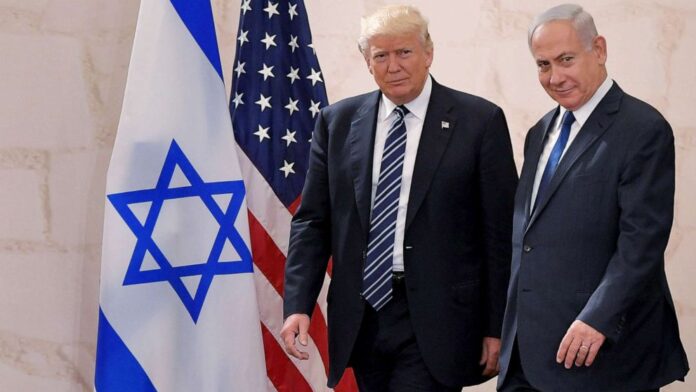Historic Trip Coincides with Gaza Ceasefire Agreement
In what he described as a “historic day,” US President Donald Trump embarked on a whirlwind diplomatic tour of the Middle East, coinciding with a long-awaited ceasefire deal in Gaza. The agreement, brokered in Doha and hailed by the White House as a turning point, has brought a fragile halt to two years of devastating war between Israel and Hamas.
As Air Force One touched down in Tel Aviv, Trump appeared eager to cast himself as the architect of peace in a region scarred by decades of bloodshed. “It’s been three thousand years in the making,” he told reporters, calling the truce “everlasting peace” under his leadership.
But beneath the celebratory tone lay lingering questions about whether the deal could endure — and what would come next for Gaza’s future.
Air Force One Lands in Tel Aviv to Warm Welcome

Travelling with the White House press corps, reporters witnessed a display of pageantry and symbolism from the moment Air Force One approached Israel. The aircraft made a low pass over Tel Aviv’s beachfront, where a massive sand display reading “Thank You Trump” — complete with an Israeli flag and Trump’s silhouette — greeted the president.
The spectacle set the tone for what was less a policy mission and more a victory lap. Trump’s day was filled with celebrations of the ceasefire rather than concrete plans for the so-called “Phase Two” — rebuilding Gaza and shaping its political landscape.
Upon arrival, Trump was met on the tarmac by Israeli Prime Minister Benjamin Netanyahu, who welcomed him with a red carpet and military band. From there, the presidential convoy sped along a cleared Route 1 highway toward Jerusalem, signaling the high-level importance of the visit.
Celebrations and Caution as Hostages Return Home

In Tel Aviv’s Hostages Square, thousands of Israelis gathered to watch live footage of the hostages released from Gaza. Tears of relief and gratitude flowed as screens displayed their reunion — split alongside images of Trump arriving in Israel.
The simultaneous events marked a moment of emotional release for both nations: the ceasefire’s first tangible sign of hope. In exchange for the hostages, Israel released several Palestinian detainees, part of the deal’s broader humanitarian provisions.
But analysts cautioned that while the truce halted active combat, deep political divides and unresolved grievances still threatened to unravel the agreement.
Trump Addresses Israeli Parliament: “A Dawn of Peace”
In Jerusalem’s Knesset, Trump was greeted like a celebrity. Lawmakers donned red caps reading “The President of Peace” as they applauded the US leader’s arrival.
During his address, Trump proclaimed a “historic dawn of a new Middle East,” declaring that Israel, with America’s support, had “won all it could by force of arms.”
However, his speech veered beyond diplomacy — featuring personal jabs at his political rivals back home and even a direct plea to Israel’s president, Isaac Herzog, to pardon Netanyahu, who faces corruption charges. “Cigars and champagne — who the hell cares about that?” Trump quipped, drawing laughter and raised eyebrows alike.
Questions Over the Future of Gaza Governance
Reporters travelling on Air Force One pressed Trump about his proposed International Stabilization Force (ISF) — a multinational peacekeeping mission mentioned in his 20-point plan but not yet agreed upon by the parties.
“It’s going to be a big, strong force,” Trump replied confidently. “But it’ll barely have to be used. Everyone knows their place now.”
Critics argue that such optimism ignores the complex realities of Gaza, where governance, reconstruction, and security remain contentious. For many observers, Trump’s rhetoric may be running ahead of reality.
Trump’s Egypt Stop: “Peace in the Middle East”
After less than seven hours in Israel, the motorcade returned to Ben Gurion Airport. From there, Air Force One made the short hop to Sharm el-Sheikh, Egypt, the site of the Qatar-brokered negotiations.
Escorted by Egyptian F-16 fighter jets, Trump was welcomed by President Abdel Fattah el-Sisi, who emphasized that a two-state solution remains the ultimate goal. Behind Trump, a giant banner read “PEACE IN THE MIDDLE EAST” as world leaders lined up for a ceremonial photo.
Trump hailed the day’s events as proof of his unique ability to “make deals no one else could,” claiming the peace process had taken “3,000 years” to reach this point.
Fragile Triumph Amid Regional Uncertainty
Despite Trump’s triumphal tone, diplomats warned that the truce remains delicate. The ceasefire, though widely welcomed, could easily unravel without sustained international cooperation and credible plans for Gaza’s governance.
Observers noted that Trump’s shifting alliances — increasingly favoring Gulf nations over a frustrated Israeli leadership — reflect the volatile balancing act of Middle East diplomacy.
As Air Force One departed for Washington in the early hours, Trump described his whirlwind day as “historic, to put it mildly.” Yet even he acknowledged that the journey toward lasting peace in the Middle East is far from over.

